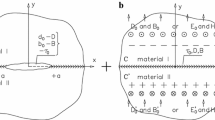Abstract
An interface crack with a frictionless contact zone at the right crack tip between two semi-infinite piezoelectric/piezomagnetic spaces under the action of a remote mechanical loading, magnetic and electric fluxes as well as concentrated forces at the crack faces is considered. Assuming that all fields are independent on the coordinate x 2 co-directed with the crack front, the stresses, the electrical and the magnetic fluxes as well as the derivatives of the jumps of the displacements, the electrical and magnetic potentials are presented via a set of analytic functions in the (x 1, x 3)-plane with a cut along the crack region. Two cases of magneto-electric conditions at the crack faces are considered. The first case assumes that the crack is electrically and magnetically permeable, and in the second case the crack is assumed electrically permeable while the open part of the crack is magnetically impermeable. For both these cases due to the above-mentioned representation the combined Dirichlet–Riemann boundary value problems have been formulated and solved exactly. Stress, electric and magnetic induction intensity factors are found in a simple analytical form. Transcendental equations and a closed form analytical formula for the determination of the real contact zone length have been derived for both cases of magnetic conditions in the crack region. For a numerical illustration of the obtained results a bimaterial BaTiO3–CoFe2O4 with different volume fractions of BaTiO3 has been used, and the influence of the mechanical loading and the intensity of the magnetic flux upon the contact zone length and the associated intensity factors as well as the energy release rate has been shown.
Similar content being viewed by others
References
Gao C.-F., Kessler H., Balke H.: Crack problems in magnetoelectroelastic solids. Part I: exact solution of a crack. Int. J. Eng. Sci. 41, 969–981 (2003)
Gao C.-F., Kessler H., Balke H.: Crack problems in magnetoelectroelastic solids. Part II: general solution of collinear cracks. Int. J. Eng. Sci. 41, 983–994 (2003)
Nirauala O.P., Wang B.L.: A magneto-electro-elastic material with a penny-shaped crack subjected to temperature loading. Acta Mech. 187, 151–168 (2006)
Feng W.J., Su R.K.L., Pan E.: Fracture analysis of penny-shaped magnetically dialectric crack in a magnetoelectroelastic material. Int. J. Fract. 146, 125–138 (2007)
Gao C.-F., Tong P., Zhang T.-Y.: Interfacial crack problem in magneto-electroelastic solids. Int. J. Eng. Sci. 41, 2105–2121 (2003)
Li R., Kardomateas G.A.: The mixed mode I and II interface crack in piezoelectromagneto-elastic anisotropic bimaterials. Trans. ASME J. Appl. Mech. 74, 614–627 (2007)
Sih G.C., Song Z.F.: Magnetic and electric poling effects associated with crack growth in BaTiO 3–CoFe 2 O 4 composite. Theor. Appl. Fract. Mech. 39, 209–227 (2003)
Song Z.F., Sih G.C.: Crack initiation behaviour in magnetoelectroelastic composite under in-plane deformation. Theor. Appl. Fract. Mech. 39, 189–207 (2003)
Gao C.-F., Noda N.: Thermal-induced interfacial cracking of magnetoelectroelastic materials. Int. J. Eng. Sci. 42, 1347–1360 (2004)
Gao C.-F., Tong P., Zhang T.-Y.: Fracture mechanics for a mode III crack in a magnetoelectroelastic solid. Int. J. Solids Struct. 41, 6613–6629 (2004)
Li R., Kardomateas G.A.: The mode III interface crack in piezo-electro-magneto-elastic dissimilar bimaterials. Trans. ASME J. Appl. Mech. 73, 220–227 (2006)
Williams M.L.: The stresses around a fault or cracks in dissimilar media. Bull. Seismological Soc. Am. 49, 199–204 (1959)
Rice J.R.: Elastic fracture mechanics concept for interfacial cracks. J. Appl. Mech. 55, 98–103 (1988)
Comninou M.: The interface crack. J. Appl. Mech. 44, 631–636 (1977)
Atkinson C.: The interface crack with contact zone (an analytical treatment). Int. J. Fract. 18, 161–177 (1982)
Simonov I.V.: The interface crack in homogeneous field of stresses. Mech. Compos. Mater. 969–976 (1985)
Dundurs J., Gautesen A.K.: An opportunistic analysis of the interface crack. Int. J. Fract. 36, 151–159 (1988)
Qin Q.-H., Mai Y.-W.: A closed crack tip model for interface cracks in thermopiezoelectric materials. Int. J. Solids Struct. 36, 2463–2479 (1999)
Herrmann K.P., Loboda V.V.: Fracture mechanical assessment of electrically permeable interface cracks in piezoelectric bimaterials by consideration of various contact zone models. Arch. Appl. Mech. 70, 127–143 (2000)
Herrmann K.P., Loboda V.V., Govorukha V.B.: On contact zone models for an electrically impermeable interface crack in a piezoelectric bimaterial. Int. J. Fract. 111, 203–227 (2001)
Hao T.H., Shen Z.Y.: A new electric boundary condition of electric fracture mechanics and its applications. Eng. Fract. Mech. 47, 793–802 (1994)
Gruebner O., Kamlah M., Munz D.: Finite element analysis of cracks in piezoelectric materials taking into account the permittivity of the crack medium. Eng. Fract. Mech. 70, 1399–1413 (2003)
Wang B.-L., Mai Y.-W.: Applicability of the crack faces electromagnetic boundary conditions for fracture of magnetoelectroelastic materials. Int. J. Solids Struct. 44, 387–398 (2007)
Kharun I.V., Loboda V.V.: A set of interface cracks with contact zones in combined tension-shear field. Acta Mech. 166, 43–56 (2003)
Herrmann K.P., Loboda V.V., Komarov A.V.: Contact zone assessment for a fast growing interface crack in an anisotropic bimaterial. Arch. Appl. Mech. 74, 118–129 (2004)
Winch R.: Electricity and Magnetism. Prentice-Hall, New Jersey (1963)
Muskhelishvili N.I.: Some Basic Problems of the Mathematical Theory of Elasticity. Noordhoff, Leyden (1975)
Eshelby J.D., Read W.T., Shockley W.: Anisotropic elasticity with application to dislocation theory. Acta Metall. 1, 251–259 (1953)
Suo Z., Kuo C.M., Barnett D.M., Willis J.R.: Fracture mechanics for piezoelectric ceramics. J. Mech. Phys. Solids 40, 739–765 (1992)
Author information
Authors and Affiliations
Corresponding author
Rights and permissions
About this article
Cite this article
Herrmann, K.P., Loboda, V.V. & Khodanen, T.V. An interface crack with contact zones in a piezoelectric/piezomagnetic bimaterial. Arch Appl Mech 80, 651–670 (2010). https://doi.org/10.1007/s00419-009-0330-1
Received:
Accepted:
Published:
Issue Date:
DOI: https://doi.org/10.1007/s00419-009-0330-1




